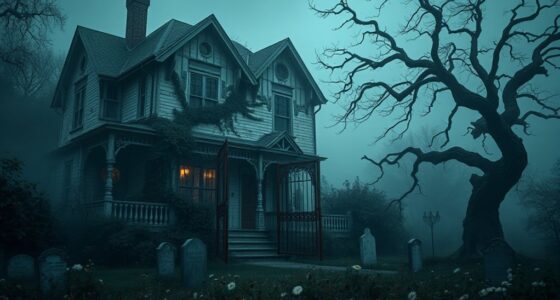Crisis apparitions are sudden, fleeting visions or shadows that appear during extreme stress or disasters, often offering subconscious messages, comfort, or warnings. You might notice them as brief figures or shadows that seem highly real, blurring the line between the physical and spiritual worlds. They can evoke feelings of fear, wonder, or reassurance, serving as tools for coping and understanding during chaos. If you want to explore what these experiences mean, there’s more to discover beyond this overview.
Key Takeaways
- Crisis apparitions are fleeting, often appearing suddenly during stressful events, and are perceived as meaningful messages from beyond.
- They can manifest as shadows or figures, providing guidance, reassurance, or insight during emergencies.
- Visions related to crises are vivid, memorable, and may foretell danger or safety, serving as subconscious alerts.
- Such apparitions hold psychological and spiritual significance, helping individuals cope, reflect, and connect with the unseen.
- Recognizing and understanding these phenomena can aid emotional resilience and offer deeper insights during times of crisis.

During times of crisis, many people report witnessing apparitions that seem to appear suddenly and vanish just as quickly. These experiences often leave a lasting impression, blending feelings of fear, wonder, and sometimes reassurance. Ghostly encounters during such moments are frequently described as fleeting figures or shadows that seem to materialize out of thin air, only to dissolve before you can get a clear look. These apparitions are often interpreted as messages from beyond, offering guidance, warning, or comfort amid chaos. Such encounters can feel intensely real, making you question the boundaries between the physical and spiritual worlds. Many who experience these phenomena believe they serve a purpose, especially when linked to premonitory visions—visions that foretell future events related to the crisis at hand.
Premonitory visions during crises tend to be vivid and memorable. They often occur in dreams or moments of heightened emotion, and may present scenes or symbols that later prove to be accurate warnings. These visions could come in the form of a sudden flash of insight or a dream that reveals impending danger. For example, during natural disasters or wartime, individuals have reported seeing visions of destruction or safety that later align with what actually unfolds. Such premonitions can serve as a subconscious alert, giving you a sense that something significant is about to happen. They can also evoke feelings of dread or hope, depending on their content. Many believe that these visions are a way for the subconscious to process the chaos around you, tapping into a deeper awareness that exceeds ordinary perception.
Experiencing ghostly encounters and premonitory visions during crises can be unsettling, yet they often provide a sense of connection to the larger universe. Some interpret these phenomena as messages from spirits or ancestors, trying to guide you through turbulent times. Others see them as manifestations of your own mind, activated by stress and fear, trying to prepare you emotionally and mentally. Regardless of their origin, these experiences tend to be intensely personal and meaningful, often prompting reflection on mortality, purpose, and the unknown. If you find yourself witnessing these apparitions or visions, it’s important to stay grounded and seek support if needed. Recognize that such phenomena can be a natural response to extreme circumstances, serving as both a psychological coping mechanism and a spiritual phenomenon. Whether you view them as supernatural messages or subconscious signals, these encounters during crises remind you that even in chaos, there’s a profound, often unseen, layer of meaning waiting to be uncovered.
Frequently Asked Questions
Can Crisis Apparitions Predict Future Events Accurately?
Crisis apparitions aren’t reliable for predicting future events accurately. While some believe psychic predictions or supernatural encounters during crises hint at upcoming dangers, there’s no solid evidence they can consistently forecast what’s ahead. You might experience vivid visions or encounters that seem to warn you, but these often lack verifiable accuracy. Trust your instincts, but don’t rely solely on supernatural encounters for vital predictions—they’re more about emotional impact than precise foresight.
Are Crisis Apparitions More Common in Certain Cultures?
You might find that crisis apparitions are more common in cultures with strong spiritual beliefs, with studies showing up to 60% of certain communities reporting such experiences. Cultural interpretations heavily influence how people perceive these visions, often viewing them as messages from loved ones or spiritual guides. In societies where spiritual beliefs are central, these apparitions are seen as meaningful and real, making them more prevalent compared to secular cultures.
What Psychological Factors Contribute to Experiencing Crisis Apparitions?
You experience crisis apparitions partly because your grief processing influences your mind, making you more prone to such visions. Cognitive biases, like confirmation bias, lead you to interpret ambiguous stimuli as meaningful or related to your loved ones. Stress and emotional turmoil heighten your sensitivity, increasing the likelihood of these apparitions. These psychological factors combine, shaping your perception and creating the powerful experience of crisis apparitions during times of loss.
How Do Experts Differentiate Between Hallucinations and Genuine Apparitions?
Imagine you’re a detective piecing together a mystery; experts differentiate hallucinations from genuine apparitions through thorough psychological assessments and analyzing sensory distortions. They look for consistency, context, and emotional impact, much like verifying a suspect’s story. For instance, if someone reports seeing a loved one during grief, but their mental state shows high stress or trauma, experts might lean toward hallucinations rather than authentic encounters.
Do Children Perceive Crisis Apparitions Differently Than Adults?
Yes, children perceive crisis apparitions differently than adults due to developmental differences. Their childhood perception is often more vivid and imaginative, making them more susceptible to experiencing or interpreting these visions uniquely. You might notice children describing apparitions with more detail or emotion, influenced by their cognitive development. As they grow, their understanding becomes more rational, which can alter how they perceive and report such experiences.
Conclusion
As you explore crisis apparitions, remember you’re not alone—about 60% of people report witnessing such phenomena during times of crisis. These vivid, meaningful encounters often offer comfort or guidance when you need it most. Whether real or imagined, they remind you that the boundary between the known and unknown can blur during life’s most challenging moments. Keep an open mind; you might find that these visions are more common—and more significant—than you ever thought.









